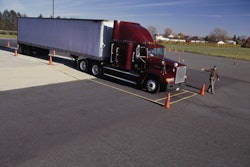Arkansas Best Corp. today, April 25, announced first-quarter 2007 revenue of $422.6 million compared to $425.0 million in the first quarter of 2006. Arkansas Best’s first-quarter 2007 income from continuing operations was $4.8 million compared to $5.8 million in the first quarter of 2006.
ABF Freight System, the company’s largest subsidiary, had first-quarter 2007 revenue of $407.4 million, a per-day decrease of 1.5 percent compared to first-quarter 2006 revenue of $413.7 million. First-quarter 2007 operating income at ABF was $5.8 million compared to $8.4 million during the first quarter of 2006. ABF’s first quarter 2007 operating ratio was 98.6 percent versus an operating ratio of 98.0 percent during the first quarter of 2006. ABF’s total weight per day decreased by 5.8 percent during the first quarter of 2007 compared to the first quarter of 2006. In contrast, in the first quarter of 2006, ABF’s total weight per day increased 4.4 percent versus the first quarter of 2005.
“In October of 2006, ABF’s tonnage declined significantly compared to the previous year,” said Robert A. Davidson, president and chief executive officer of Fort Smith, Ark.-based Arkansas Best. “In November, when it became apparent that fourth-quarter tonnage would be below expectations, ABF began reducing costs to better match available business levels. Those tonnage declines have continued into 2007. However, the expense reduction steps first initiated last November helped better align ABF’s network with existing business. As a result, lower tonnage had less of an impact on ABF’s operating ratio than we’ve seen in previous downturns or in the fourth quarter of 2006.”
As mentioned in previous quarters, investments in ABF’s Regional Performance Model initiative increased ABF’s first-quarter operating ratio by 1.2 percentage points, Davidson said. “Abnormally severe February weather also added about one-half of a percentage point to the first-quarter 2007 operating ratio,” he said. Compared to the same period last year, ABF’s first-quarter 2007 operating ratio was improved by 0.7 of a percentage point due to lower expense associated with workers’ compensation and third-party casualty claims. The combined costs of these programs in the first quarter of 2007 were in line, as a percent of revenue, with ABF’s recent five-year average. In the first quarter of 2006, these costs were unusually high.
Total billed revenue per hundredweight was $24.79, an increase of 4.0 percent over last year’s first-quarter figure of $23.83. The percentage increase in first-quarter pricing was positively affected by profile changes in ABF’s business, including a decrease in total weight per shipment and an increase in the shipment commodity class. “Considering the challenging freight demand that exists today, ABF has achieved acceptable price increases throughout its broad base of accounts,” Davidson said. “ABF continues to maintain its traditional pricing emphasis on individual account profitability. Even during a period of reduced business, ABF will work to provide value to its customers in return for a level of revenue that yields acceptable operating margins.”
ABF said its Regional Performance Model, which provides improved next-day and second-day services in the eastern two-thirds of the United States, is fully operational, and ABF’s sales team is actively marketing these services. Because the company is in the early stages of the marketing effort, RPM did not have a material impact on ABF’s system revenue totals in the first quarter of 2007. “As we expected in the early stages of this new initiative, costs are exceeding associated revenues,” Davidson said. “As a result, for now, RPM continues to affect ABF’s operating margins. However, we believe that the opportunity for long-term growth of business and operating margins resulting from ABF’s presence in the regional market is well worth the initial investments we are now making.
“ABF is finding success with customers once they experience our services on these shorter-distance shipments and realize we are competitive in both delivery time consistency and price,” Davidson said. “In many cases, these customers appreciate ABF’s high level of service, the problem-solving attitude of ABF’s sales representatives and its superior cargo care. As these individual customer success stories continue to build, ABF’s market share in the regional space should become more meaningful.”









